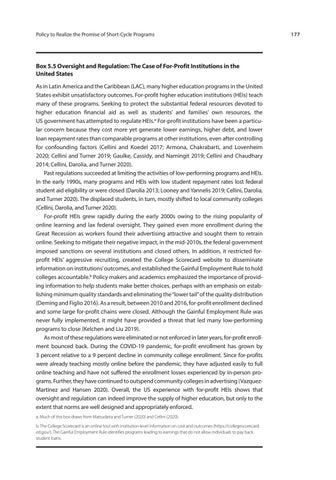Policy to Realize the Promise of Short-Cycle Programs
Box 5.5 Oversight and Regulation: The Case of For-Profit Institutions in the United States As in Latin America and the Caribbean (LAC), many higher education programs in the United States exhibit unsatisfactory outcomes. For-profit higher education institutions (HEIs) teach many of these programs. Seeking to protect the substantial federal resources devoted to higher education financial aid as well as students’ and families’ own resources, the US government has attempted to regulate HEIs.a For-profit institutions have been a particular concern because they cost more yet generate lower earnings, higher debt, and lower loan repayment rates than comparable programs at other institutions, even after controlling for confounding factors (Cellini and Koedel 2017; Armona, Chakrabarti, and Lovenheim 2020; Cellini and Turner 2019; Gaulke, Cassidy, and Namingit 2019; Cellini and Chaudhary 2014; Cellini, Darolia, and Turner 2020). Past regulations succeeded at limiting the activities of low-performing programs and HEIs. In the early 1990s, many programs and HEIs with low student repayment rates lost federal student aid eligibility or were closed (Darolia 2013; Looney and Yannelis 2019; Cellini, Darolia, and Turner 2020). The displaced students, in turn, mostly shifted to local community colleges (Cellini, Darolia, and Turner 2020). For-profit HEIs grew rapidly during the early 2000s owing to the rising popularity of online learning and lax federal oversight. They gained even more enrollment during the Great Recession as workers found their advertising attractive and sought them to retrain online. Seeking to mitigate their negative impact, in the mid-2010s, the federal government imposed sanctions on several institutions and closed others. In addition, it restricted forprofit HEIs’ aggressive recruiting, created the College Scorecard website to disseminate information on institutions’ outcomes, and established the Gainful Employment Rule to hold colleges accountable.b Policy makers and academics emphasized the importance of providing information to help students make better choices, perhaps with an emphasis on establishing minimum quality standards and eliminating the “lower tail” of the quality distribution (Deming and Figlio 2016). As a result, between 2010 and 2016, for-profit enrollment declined and some large for-profit chains were closed. Although the Gainful Employment Rule was never fully implemented, it might have provided a threat that led many low-performing programs to close (Kelchen and Liu 2019). As most of these regulations were eliminated or not enforced in later years, for-profit enrollment bounced back. During the COVID-19 pandemic, for-profit enrollment has grown by 3 percent relative to a 9 percent decline in community college enrollment. Since for-profits were already teaching mostly online before the pandemic, they have adjusted easily to full online teaching and have not suffered the enrollment losses experienced by in-person programs. Further, they have continued to outspend community colleges in advertising (VazquezMartinez and Hansen 2020). Overall, the US experience with for-profit HEIs shows that oversight and regulation can indeed improve the supply of higher education, but only to the extent that norms are well designed and appropriately enforced. a. Much of this box draws from Matsudaira and Turner (2020) and Cellini (2020). b. The College Scorecard is an online tool with institution-level information on cost and outcomes (https://collegescorecard. ed.gov/). The Gainful Employment Rule identifies programs leading to earnings that do not allow individuals to pay back student loans.
177

